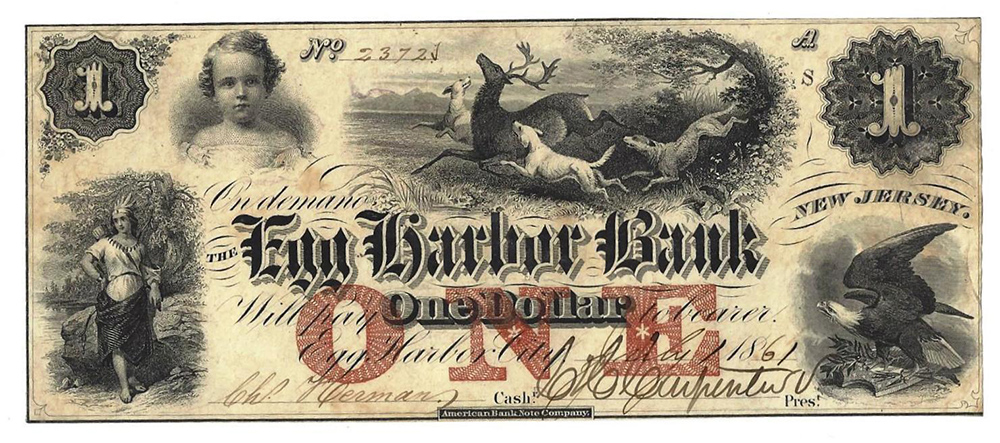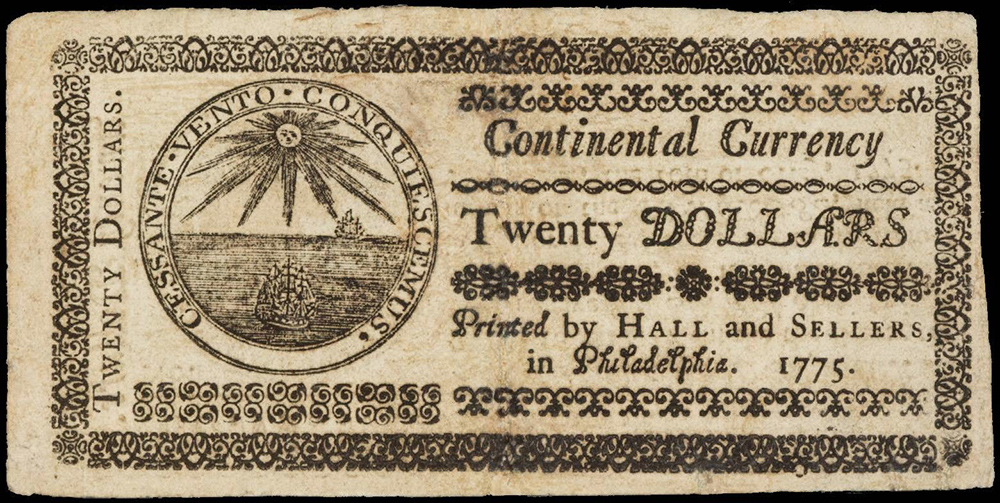Shore Collectibles
By Douglas Keefe
The first issuance of paper money in the colonies was the printing of notes by the province of Massachusetts Bay to pay for a military expedition. One by one the other colonies followed by printing their own notes to pay for expenses. Initially they followed the British pound-sterling system, but a Massachusetts pound was not the same as a Pennsylvania pound and always less than the British pound. Since Spanish coins circulated freely in the colonies, some colonies started placing the denomination in Spanish milled dollars (8 reales or “pieces of eight”). Although they were issued in terms of pounds or milled dollars, they were not intended to be exchanged for hard money, only to be used as payment.
In June of 1775, the Second Continental Congress authorized the printing of $2 million in the form of Continental currency. Although the Declaration of Independence had not yet been written, it was evident that a breach from England would occur and money was needed to finance the result. After July 4th, 1776 and the ensuing years of war with England, some $240 million dollars of Continental currency was printed to finance the war. Unfortunately, with inflation and the uncertainty of success, the value declined to where they were worthless, hence the term “not worth a Continental”. Fortunately for those soldiers and merchants who accepted Continental notes, they were ultimately redeemed, albeit in some cases, many years later.

During the early 1800’s after the creation of the United States and the building of the Philadelphia mint, most transactions were in gold and silver, not just our own currency, but also that from other countries. In fact, Spanish 8 reales traded as legal tender dollars until 1857. However, as a means to facilitate monetary transactions, banks were created both as a depository for hard cash and to issue paper money which would be easier to transport. The premise was simple, a bank could receive a charter and would hold in reserve enough gold and silver to back up the paper money they printed. This era lasted until the Civil War and is known as the Broken Bank period and the currency as obsolete notes. There are many reasons for the failure of this system not the least of with was the temptation of the owners of the bank to print more paper than the gold and silver they had in reserve to back up the notes. A run on the bank to exchange the currency for gold or silver would cause it to go broke, hence the term “Broken Bank Note”.
A second problem was the size of the country with no direct means of communication. Letters, which were the main means of communication could take days, even weeks to reach their destination, so someone in Virginia receiving a note from Boston would have no way to determine if the note was good or not, and in many cases it wasn’t. The number of banks created during this period was huge, with some being in adjoining towns. Also, a bank could fail one week and be resurrected the next with a new name but the same officers.
The third problem was counterfeiting. Some counterfeiters would design notes on fictious banks at far away locations and pass them to unsuspecting people. As a result, the trust level for paper money was quite low.
Then came the Civil War and the Unions’ need for money.
Continued next week.
Douglas Keith is the President of Beachcomber Coins, Inc. He and his wife Linda operate Beachcomber Coins and Collectibles, formally located in the Shore Mall and now located at 6692 Black Horse Pike, Egg Harbor Township in the old Wawa building. They also have satellite offices for buying only in Brigantine (Saturday), and in Absecon (Tuesday). Between them, they have over 70 years of experience buying and selling coins, collectibles in precious metals. They are members of the American Numismatic Association, the Industry Council of Tangible Assets, the Numismatic Guarantee Corporation, the Certified Coin Exchange and the Professional Coin Grading Service. Visit their website at www.beachcombercoinsinc.com for video and information.






